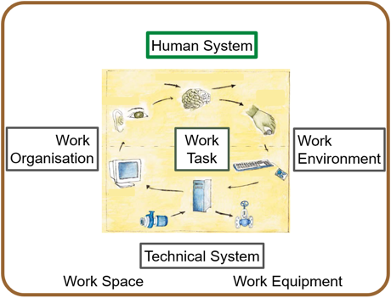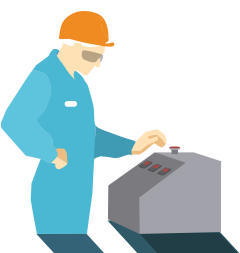The Concept of Work System Design
In human factors and ergonomics (HF&E), the work system comprises workers and work equipment acting together to perform the system function in the workspace, in the work environment, under the conditions imposed by the work tasks. For example, a canning factory or a workstation for assembling electronic pumps could be defined as a work system. In HF&E disciplines, work system design is a flexible and iterative process that takes into account system components and interdependencies between system components (e.g. work task, work organisation, work environment). As a result, the design of the whole system is more than the sum of its parts. The design of a work system should follow general design criteria and should follow design strategies that refer to appropriate user populations.

The initial step in the design process in HF&E is the definition of the work system, i.e. a description of the work system that comprises a determination of the limits of the work system under consideration. It should also include a classification of the work system in superordinate and the subordinate structures as illustrated by the following example. When considering, for example, a workstation for assembling an electric pump as a work system, a manufacturing site is a superordinate system and a computer-aided quality control workplace belonging to the workstation is a subordinate system. The description of the work system including determination of the limits of the work system should be described in a document.
The next step in the design process is the analysis and documentation of the human work task. This serves as a framework for the design of all other system components (e.g. work environment, work space, work equipment). Descriptions of all other system components follow and include interactions between components. The design of system components and their interactions should satisfy normative standards.
The design of a work system follows general design criteria referring to human performance, safety and health as well as design strategies referring to appropriate user populations.
The aim of work systems design according to HF&E requirements is designing working conditions for human operators that
- result in optimal operator workload,
- ensure human safety, health and well-being, and
- optimise overall system performance.
References:
- EN 614-1. Safety of machinery – Ergonomic design principles - Part 1: Terminology and general principles.
- EN 614-2. Safety of machinery – Ergonomic design principles – Part 2: Interactions between the design of machinery and work tasks.
- EN ISO 6385. Ergonomic principles in the design of work systems.
- Sanders, M.S. & McCormick, E.J. (1993). Human factors in engineering and design. New York: McGraw Hill.

